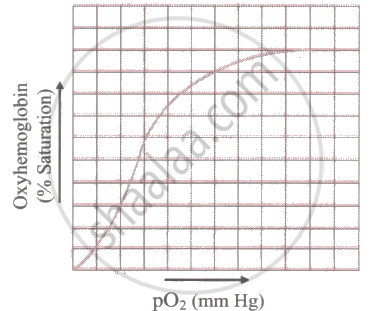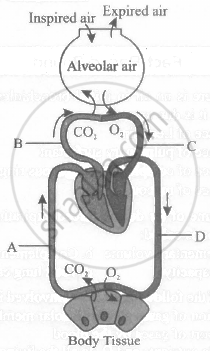Advertisements
Advertisements
प्रश्न
Explain the transport of O2 and CO2 between alveoli and tissue with diagram.
उत्तर
Transportation of Oxygen:
- The oxygen we breathe reaches our alveoli.
- Because the partial pressure of oxygen in alveoli is higher, oxygen diffuses to capillaries and mixes with haemoglobin to create oxyhaemoglobin.
- Oxygenated blood is delivered to an organ with a lower partial pressure than alveoli.
- In these organs, the connection between oxygen and haemoglobin will be fragile and will break, allowing oxygen to enter the organs.
Transportation of Carbon Dioxide:
- Various organs emit carbon dioxide, which is transported to the alveoli via capillaries, which have a lower intrapulmonary pressure than the organs.
- Because the intrapulmonary pressure in the alveoli is lower than in the capillaries, carbon dioxide will pass from the capillaries to the alveoli.
- Carbon dioxide mixes with water in red blood cells to generate carbonic acid. It's an unstable state that breaks down into hydrogen and bicarbonate ions.
- Bicarbonate ions, which are carbon dioxide ions, are likewise carried by plasma.

APPEARS IN
संबंधित प्रश्न
What is the effect of pCO2 on oxygen transport?
Can you suggest any reason for the sigmoidal pattern of the oxygen dissociation curve?"
Have you heard about hypoxia? Try to gather information about it, and discuss with your friends.
A sigmoid curve is obtained when the percentage saturation of haemoglobin (Hb) with oxygen is plotted against the \[\ce{PO2}\] as indicated below:

The given figure shows diagrammatic representation of exchange of gases at the alveolus and the body tissues with blood and transport of oxygen and carbon dioxide. Identity the blood vessels A to D.
Oxygen carrying capacity of blood is ______.
Select the favourable conditions required for the formation of oxyhaemoglobin at the alveoli.
It is known that exposure to carbon monoxide is harmful to animals because ______.
The oxygen-haemoglobin dissociation curve will show a right shift in case of ______.
What is the amount of O2 supplied to tissues through every 100 ml. of oxygenated blood under normal physiological conditions?
